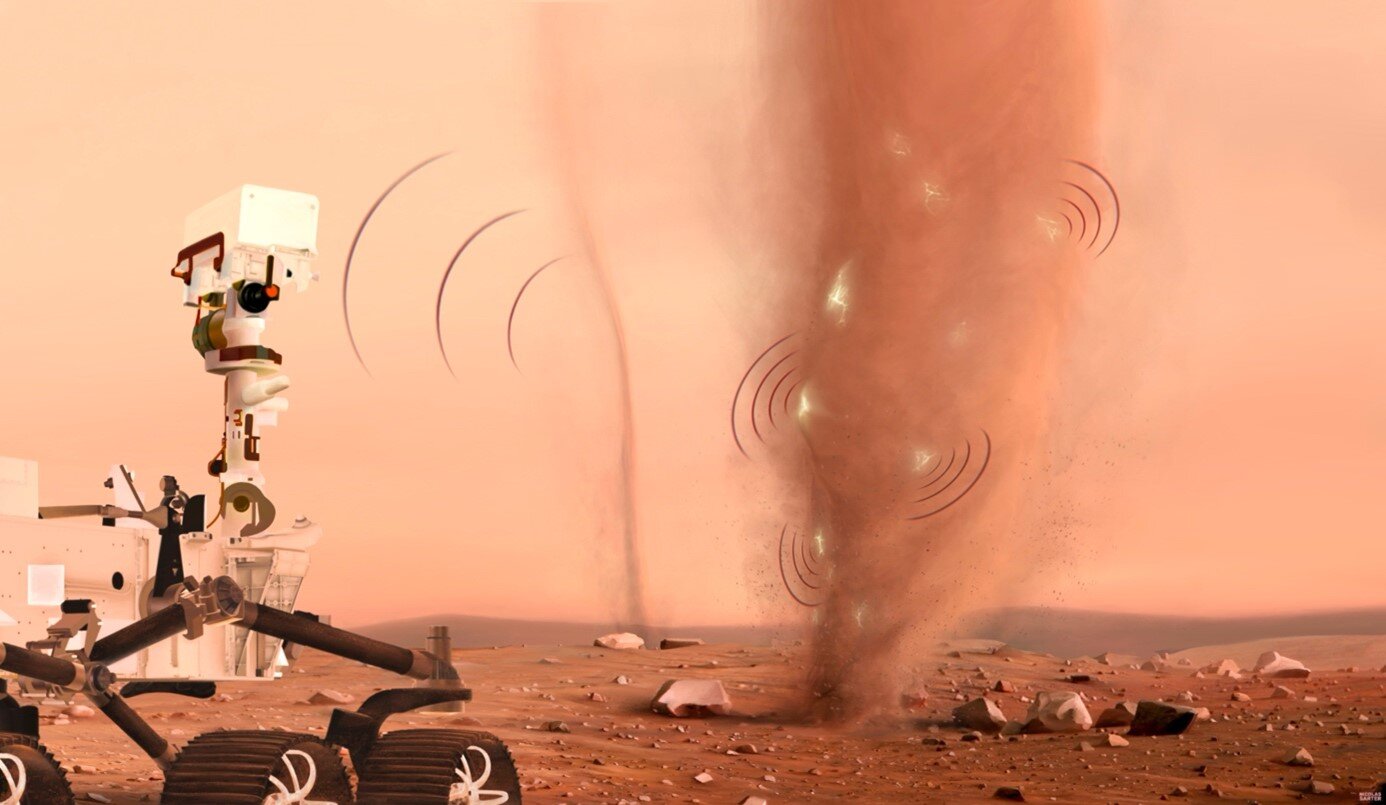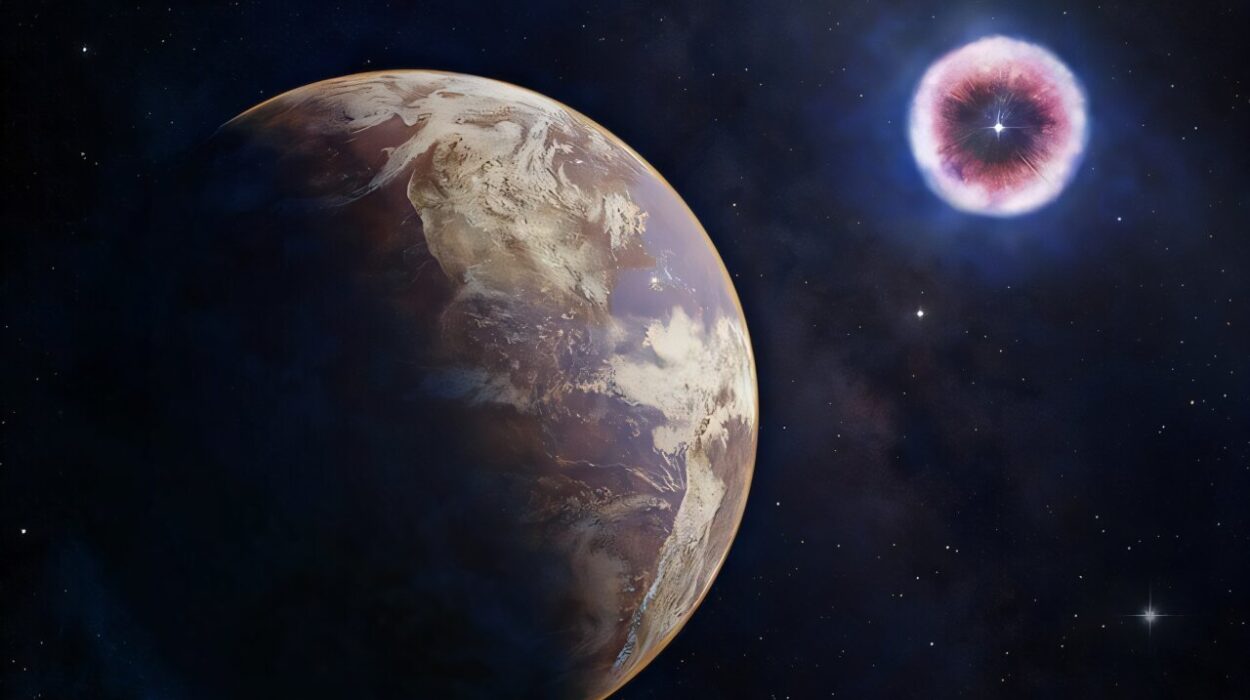In the dusty, windswept plains of Mars, something unusual is happening. Every day, winds whip across the surface of the Red Planet, churning up fine particles of dust into swirling whirlwinds. These whirlwinds, known as dust devils, are a common sight on Mars. But in the heart of two of these dust devils, a surprising sound was captured—one that would change our understanding of Martian chemistry forever.
For the first time, scientists were able to hear the sound of electric discharges on Mars, thanks to the SuperCam instrument aboard NASA’s Perseverance rover. The microphone on SuperCam, which had been listening to the Martian winds and recording various sounds since 2021, inadvertently recorded the electromagnetic and acoustic signatures of electric discharges—an event scientists had long theorized but had never observed. The results of this groundbreaking discovery were published in the prestigious journal Nature, and the implications of this finding are far-reaching.
The Sound of Static on Mars
It all began with the humble microphone of the SuperCam. When the Perseverance rover landed on Mars in February 2021, it brought with it an array of cutting-edge instruments, including the SuperCam. This device, capable of capturing sounds on Mars, had already provided us with the first audio recordings from the planet: the eerie whisper of wind, the hum of the Ingenuity helicopter, and the relentless stirring of dust. But no one expected it would capture the electric crackle of Martian static.
Scientists at the Institut de recherche en astrophysique et planétologie (CNES/CNRS/Université de Toulouse) and the laboratoire Atmosphères et observations spatiales (CNRS/Sorbonne Université/Université de Versailles Saint-Quentin-en-Yvelines) analyzed the signals recorded by the microphone and discovered that they weren’t just wind sounds—they were something entirely new. These were the acoustic and electromagnetic signals produced by electric discharges in the Martian atmosphere. Think of the small shock you might feel when touching a doorknob on a dry day. Now imagine that tiny spark on Mars, but with a much greater impact on the planet’s atmosphere.
The Dust that Sparks Life (and Chemistry)
The cause of these electric discharges lies in the Martian dust itself. As winds blow across the planet’s surface, dust particles rub against each other, generating static electricity through friction. In Earth’s deserts, similar phenomena occur, but the dry conditions rarely lead to noticeable discharges. On Mars, however, the situation is different. The planet’s thin atmosphere—made up almost entirely of carbon dioxide—makes it much easier for dust particles to build up a significant charge. As a result, the amount of electrical charge needed to create sparks is much lower than it would be on Earth. This is why these discharges can occur frequently, even in the planet’s dry, thin air.
When the dust particles become charged with electrons, they release their energy in the form of short electric arcs. These arcs are only a few centimeters long but create shock waves that can be heard by the SuperCam’s microphone. This phenomenon, which happens regularly in Mars’ dust devils, marks the first direct evidence of electric discharges in the Martian atmosphere. And while this discovery might seem like a small static shock on the surface, the implications for Mars’ chemistry and climate are profound.
Changing Our Understanding of Mars’ Atmosphere
What does this discovery mean for our understanding of Mars? According to the scientists involved in the study, these electrical discharges could dramatically alter our view of the Martian atmosphere. The electric arcs produced by the dust storms are more than just sparks—they could play a crucial role in speeding up the formation of highly oxidizing compounds in the atmosphere. These compounds can break down organic molecules, which are vital building blocks for life as we know it.
The significance of this cannot be overstated. Organic molecules on Mars, if they exist, could hold the key to understanding whether life ever arose on the planet. But the electrical discharges could be disrupting the stability of these molecules, preventing them from surviving long enough to form complex life forms. This could explain the mystery of the rapidly disappearing methane on Mars, a puzzle that scientists have been trying to solve for years. Methane is a key indicator of potential biological activity, and its disappearance might be linked to these discharges, which could be accelerating its breakdown.
Additionally, the electrical charges involved in these discharges are likely to have an impact on the way dust behaves on Mars. Dust plays an important role in the planet’s climate, and any factor that influences its movement could have a broader impact on Martian weather patterns and atmospheric conditions. The full extent of this is still not entirely clear, but it opens up new avenues of research into the planet’s climate dynamics.
A New Frontier for Exploration
One of the most exciting aspects of this discovery is the role of the SuperCam microphone itself. As one of the few instruments capable of capturing sound on Mars, it has already provided invaluable data about the Red Planet’s atmosphere. From the howling winds to the soft hum of Perseverance’s instruments, every sound recorded by SuperCam has added another layer to our understanding of the planet. But now, with the identification of electric discharges, the microphone has proven that it is also a powerful tool for exploring the Martian environment in ways scientists hadn’t imagined.
The potential of acoustic data in planetary exploration is immense. Just as we use sound to understand the depths of Earth’s oceans and to study the behavior of different materials, sound can be used on Mars to study the dynamics of its atmosphere, its climate, and even the activity of dust storms. The microphone aboard SuperCam has revealed a hidden side of Mars that scientists can now investigate with fresh eyes, offering new insights into the planet’s environmental processes.
Why This Discovery Matters
So, why does this discovery matter? It matters because it reshapes our understanding of Mars and its atmosphere. For years, scientists had speculated that electric discharges could occur on Mars, but no one had been able to observe them directly—until now. These findings don’t just confirm a long-held theory, they introduce new questions about how these discharges affect the Martian environment and, by extension, the possibility of life on Mars.
The implications of this discovery also reach beyond Mars. Understanding the role of electrical discharges in planetary atmospheres could provide insight into similar processes on other planets, moons, and even exoplanets. As we push forward into the exploration of the cosmos, every piece of information we gather from Mars helps us prepare for future missions to the Moon, Venus, and beyond. And who knows? The study of electric discharges on Mars could one day be a key part of making a human mission to the Red Planet a reality.
In the end, this discovery is a reminder of just how much there is still to learn about Mars. Even as we explore its surface with rovers and orbiters, the planet continues to surprise us, offering up mysteries and secrets that challenge our understanding of the universe. Thanks to the SuperCam microphone, we’ve heard something new—something small, but significant. A spark of discovery on Mars that could light the way for future exploration.
More information: Baptiste Chide et al, Detection of triboelectric discharges during dust events on Mars, Nature (2025). DOI: 10.1038/s41586-025-09736-y






